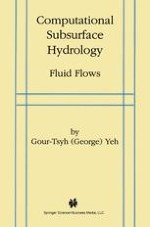1999 | Buch
Über dieses Buch
Computational Subsurface Hydrology: Fluid Flows offers practicing engineers and scientists a theoretical background, numerical methods, and computer codes for the modeling of fluid flows in subsurface media. It will also serve as a text for senior and graduate courses on fluid flows in subsurface media in disciplines such as civil and environmental engineering, agricultural engineering, geosciences, soil sciences, and chemical engineering.
Computational Subsurface Hydrology: Fluid Flows presents a systematic derivation of governing equations and boundary conditions of subsurface fluid flow. It discusses a variety of numerical methods, expounds detailed procedures for constructing finite element methods, and describes precise implementation of computer codes as they are applied to subsurface flows.
Four computer codes to simulate vertically integrated horizontal flows (FEWA), saturated flows with moving phreatic surfaces in three dimensions (3DFEWA), variably saturated flows in two dimensions (FEMWATER), and variable flows in three dimensions (3DFEMWATER) are attached to this book. These four computer codes are designed for generic applications to both research and practical problems. They could be used to simulate most of the practical, real-world field problems.
If you would like a copy of the diskettes containing the four, basic general purpose computer codes referred to in Computational Subsurface Hydrology: Fluid Flows, please email Gour-Tsyh Yeh at the following address : gyeh@mail.ucf.edu
Anzeige
